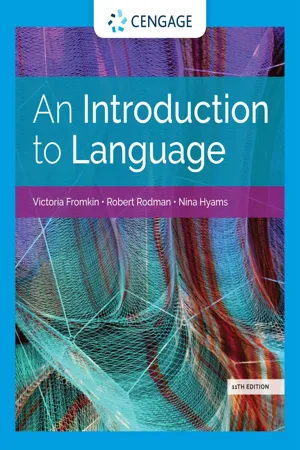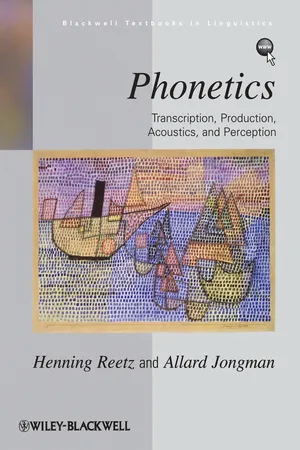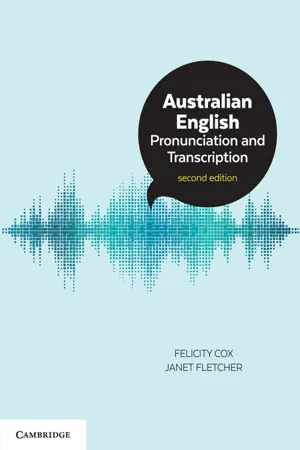Languages & Linguistics
Alveolar
In phonetics, "alveolar" refers to sounds produced by the tongue making contact with the alveolar ridge, a bony ridge located just behind the upper front teeth. Alveolar sounds are common in many languages and include sounds like /t/, /d/, /s/, and /z/. These sounds are produced by directing airflow against the alveolar ridge.
Written by Perlego with AI-assistance
Related key terms
1 of 5
9 Key excerpts on "Alveolar"
- eBook - PDF
- Lynne Cahill(Author)
- 2019(Publication Date)
- Bloomsbury Academic(Publisher)
Can you feel those positions? Can you see on figure 3.1 where this is hap-pening? For t the tongue touches the Alveolar ridge, and for k it touches the velum. The different places where consonants are produced are described by referring to these parts of the mouth, mostly using Latin terms for the parts of the mouth. Table 3.1 gives the main terms you need for this.There are more that I introduce later, but I focus on those for now. Hopefully, you all know where your lips and teeth are. The Alveolar ridge is very important for speech sounds in all languages, but you may not have come across it before. Run your tongue back from your teeth. You should feel the hard ridge just behind them. That’s the Alveolar ridge. Now keep running your tongue back from there. You should be able to feel that behind the Alveolar ridge, the roof of your mouth curves upwards into a kind of dome shape. That bit is the hard palate. Now keep running your tongue back (you’ll need to let it go kind of upside down) and you should feel that the hard part ends and there’s a softer part. The soft part is the velum (sometimes called the soft palate). Most English consonants can be described in terms of those places. The bits of the mouth used to pronounce a sound are called the articula-tors . Articulators are just bits that come together to make the vocal tract a different shape and they can be active or passive . Active articulators are ones that move, and include lips, tongue and velum. Passive articulators are ones that don’t move, and include teeth, Alveolar ridge and palate. The consonant sounds are described by referring to the articulators. In most cases, the tongue is one of the articulators, which isn’t usually mentioned, but when the tongue is not involved, the names of both articulators are used. For example, a velar sound involves the tongue moving towards or touching the velum, for example when saying k or g . - Victoria Fromkin, Robert Rodman, Nina Hyams, , Victoria Fromkin, Robert Rodman, Nina Hyams(Authors)
- 2018(Publication Date)
- Cengage Learning EMEA(Publisher)
Articulatory Phonetics 191 dental. Watch yourself in a mirror and say think or these and see where your tongue tip goes. Alveolars [t] [d] [n] [s] [z] [l] [r] All seven of these sounds are pro- nounced with the tongue raised in various ways to the Alveolar ridge. • For [t], [d], and [n], the tongue tip is raised and touches the ridge, or slightly in front of it. • For [s] and [z], the sides of the front of the tongue are raised, but the tip is lowered so that air escapes over it. • For [l], the tongue tip is raised while the rest of the tongue remains down, permitting air to escape over its sides. Hence, [l] is called a lateral (mean- ing sideways) sound. You can feel this in the l’s of Lolita. • For [r] (IPA [ɹ]), the top of the tongue is curled back behind the Alveolar ridge. As opposed to [l], when [r] is pronounced, air escapes through the central part of the mouth. Palatals [ʃ] [ӡ] [ʧ] [ʤ] [j] For these sounds, which occur in mission [mɪʃən], measure [mɛӡər], cheap [ʧip], judge [ʤʌʤ], and yoyo [jojo], the constriction occurs by raising the front part of the tongue to the palate. Velars [k] [g] [ŋ] Another class of sounds is produced by raising the back of the tongue to the soft palate or velum. The initial and final sounds of the words kick [kɪk] and gig [gɪg], and the final sounds of the words back [bæk], bag [bæg], and bang [bæŋ], are all velar sounds. Uvulars [ʀ] [q] [ɢ] Uvular sounds are produced by raising the back of the tongue to the uvula, the fleshy protuberance that hangs down in the back of our throats. The r in French is often a uvular trill symbolized by [ʀ]. The uvular sounds [q] and [ɢ] occur in Arabic. These sounds do not ordinarily occur in English. Glottals [h] [Ɂ] The sound of [h] is from the flow of air through the open glottis and past the tongue and lips as they prepare to pronounce a vowel sound, which always follows [h].- eBook - PDF
For the Love of Language
An Introduction to Linguistics
- Kate Burridge, Tonya N. Stebbins(Authors)
- 2019(Publication Date)
- Cambridge University Press(Publisher)
You can also benefit from looking at your Figure 7.1 The organs of articulation Further resources PART 3: Sounds and grammar 180 face in the mirror as you pronounce them to see what your lips are doing, although you might wait until nobody else is home for this one! • A bilabial consonant is one that involves both lips touching, as in /p, b, m/ in pat, bat and mat. • The labiodental consonants /f/ and /v/ ( fine and vine ) are produced using the bottom lip and the upper teeth as articulators. • A dental sound results from the tongue tip being inserted between (or just touching) the top and bottom teeth in the sounds /θ/ and /ð/ found in the words thin and that. • Alveolar sounds are produced through different types of contact between the tongue and Alveolar ridge (the bumpy bit behind your teeth). They include /t/, /d/, /s/, /z/, /n/, /l/ in tack, deck, sack, zoo, now and loud. If you try making these sounds, you will be able to feel that it is only the tongue tip that is involved for /t/, /d/, /n/, whereas for /s/ and /z/ the tongue adopts something of a ‘spoon-like’ form, allowing air to pass between it and the Alveolar ridge, without tongue-tip contact. The opposite occurs in the production of /l/, where the air passes over the sides of the tongue, while the tongue tip makes firm contact with the top teeth. Try saying the word slow a few times very slowly, to feel the different articulatory positions for /s/ and /l/. • PostAlveolar (or palato-Alveolar ) consonants include / ʃ/ in fish, /ʒ/ in pleasure, /tʃ/ in church and /dʒ/ in judge, all of which are produced using the tongue blade and the area of the palate located a little further back behind the Alveolar ridge. Try repeating /t/ and / ʃ/ several times in succession to feel the difference in tongue position. - eBook - ePub
Phonetics
Transcription, Production, Acoustics, and Perception
- Henning Reetz, Allard Jongman(Authors)
- 2011(Publication Date)
- Wiley-Blackwell(Publisher)
English has central approximants at three places of articulation: labial-velar (w ay), produced simultaneously with the back of the tongue raised toward the velum and with pursed or rounded lips; Alveolar (r ye), produced with the tongue tip raised toward the Alveolar ridge; and palatal (y ou), produced with the front of the tongue raised toward the palate. In a lateral approximant, the central pathway is blocked and the air flows sideways (laterally) around the blockage. English has one lateral approximant, with an Alveolar place of articulation, as in the word l ie. In the production of a lateral Alveolar approximant, the tip of the tongue makes full contact with the Alveolar ridge. However, the airflow is not interrupted because air passes around the sides of the tongue. To summarize, consonants can be described in terms of voicing, and place and manner of articulation. Voicing indicates whether a sound is voiced or voiceless. Places of articulation for English sounds are bilabial, labiodental, dental, Alveolar, postAlveolar, palatal, velar, and glottal. Manners of articulation are plosive, nasal, fricative, affricate, and approximant. In addition, two more dimensions can be used to fully specify consonants: oral/nasal to indicate whether a sound is oral or nasal, and central/lateral, to indicate whether air flows out through the center of the mouth or along the sides of the mouth. As an example, the initial consonant in the word z est can be described as a “voiced Alveolar central oral fricative.” In English, the vast majority of speech sounds involves a central articulation (only “l” is a lateral). In addition, most sounds are oral, produced with a velic closure (only “m,” “n,” and “ng” are nasal). Central and oral are therefore typically considered default values for these categories and can be left out of the specification - Felicity Cox, Janet Fletcher(Authors)
- 2017(Publication Date)
- Cambridge University Press(Publisher)
34 Australian English Pronunciation and Transcription Figure 2.6 Schematic showing bilabial place of articulation with the soft palate lowered for nasal consonants such as /m/ . . . . . . . . . . . . . . . . . . . . . . . . . . . . . . . . . . . . . . . . . . . . . . . . . . . . . . . . . . . . . . . . . . . . . . . . . . . . . . . . . . . . . . . . . . . . . . . . Figure 2.5 Schematic showing bilabial place of articulation with the soft palate raised for oral consonants such as /p, b/ . . . . . . . . . . . . . . . . . . . . . . . . . . . . . . . . . . . . . . . . . . . . . . . . . . . . . . . . . . . . . . . . . . . . . . . . . . . . . . . . . . . . . . . . . . . . . . . . Consonants and vowels 35 Apico-dental describes the tongue tip articulating with the tips or edges of the upper teeth. Lamino-dental describes the tongue blade articulating with the tips or backs of the upper front teeth and is common in Australian Aboriginal languages (Butcher 1995). The term interdental is sometimes used to describe the articulation where the tongue is between the upper and lower teeth. Speakers of English vary as to whether they produce dental or interdental articulations, and this may be due to surrounding phonetic context, individual speaker habit or dialectal variation. Figure 2.8 illustrates dental place of articulation with the soft palate raised for oral airflow. Alveolar Alveolar sounds are created by raising the tongue tip or blade to articu- late with the Alveolar ridge. For example, /t, d, s, z, l, n/ are the initial sounds in tore, door, saw, zoo, law and nor. Figures 2.9 and 2.10 illustrate oral and nasal Alveolar place of articulation respectively. In Figure 2.9 the soft palate is raised for oral consonants such as /t, d/, whereas in Figure 2.10 the soft palate is lowered to allow air to flow through the nasal cavity for the nasal sound /n/. The consonant /ɹ/ as in raw is often described as Alveolar but is more correctly considered an apical postAlveolar sound.- eBook - PDF
The German Language
A Linguistic Introduction
- Jean Boase-Beier, Ken R. Lodge(Authors)
- 2008(Publication Date)
- Wiley-Blackwell(Publisher)
94 Phonetics ones are being used. Relative position is a matter of manner of articulation; which articulators are being used is a matter of place of articulation. We shall deal with each separately. 4.6 Manner An active articulator can be in a number of different spatial relations to a passive one. If we take as an initial example the tip of the tongue (apex) and the hard ridge of bone behind the top teeth (Alveolar ridge), we can see a number of different possibilities of relationship, which modify the air-stream in different ways. If the sides of the tongue are in full contact with the side teeth and the tip is tight against the Alveolar ridge, no air can escape until it is released somehow. The air pressure builds up in the mouth, as long as air is coming up from the lungs. If the vocal cords are vibrating and the velum is closed, the removal of the tongue tip from the Alveolar ridge will cause a quick release of the air in the mouth, giving a plosive sound. We represent this as [d]; its full description is a voiced , oral , Alveolar plosive . It is also a stop , because the air-stream is stopped in the mouth. Because the air is released, it is a plosive; if the air was not released, it would still be a stop, but not a plosive. Keeping the same articulatory position in the mouth but chang-ing the phonation to voiceless will give us [t], a voiceless , oral , Alveolar stop ; changing the position of the velum but keeping the vocal cords vibrating will give us [n], a voiced , nasal , Alveolar stop . (Note that in the case of [n], and any other nasal stops, the stoppage is still in the mouth, at the Alveolar ridge for [n]; it is not in the nose.) The position of the articulators for [d] can be modified slightly by removing the tongue tip away from the Alveolar ridge very slightly, so that the air is forced through a narrow gap causing local (i.e. at the Alveolar ridge), audible friction. - eBook - PDF
- Martin J. Ball, Nicole Muller(Authors)
- 2014(Publication Date)
- Psychology Press(Publisher)
However. these different lip postures may also be an individual preference. Labiodental nasals, fricatives, affricates, and approximants are found in natural language, although labiodental plosives are very rare. ARTICULATION: CONSONANT PLACE TYPES 77 Examples of labiodental consonants in the languages of the world are seen as follows: nasal: [1l]]-(kJll]fi] (English) comfy (positional variant of English m'? fricatives: [f], [v]-[faka], [vaka] (Portuguese) knife, cow affricates: [pr]-[prarfan] (German) to whistle approximant: [u]-[uazi] (Tamil) path ANTERIOR LINGUAL There are four main places of articulation made with the anterior part of the tongue (that is, the tip and the blade): dental, Alveolar, postAlveolar, and retroflex. These four are illustrated in Fig. 7.4. In dental articulations, the tip of the tongue is the active articulator and the inside of the upper front teeth is the passive articulator. Dental articulations can be found for all the main consonant types: nasal, plosive, fricative, affricate. and approximant. Whereas English has an Alveolar place of articulation for sounds such as It, d, n, 1], many languages use a dental place for these sounds. However, the difference in sound quality between dental and Alveolar is slight. and it is comparatively rare to find languages that contrast them (though Malayalam Dental Alveolar f'lG 7.4. lnterior linguc11 articuldtion types. 78 CHAPTER 7 PostAlveolar Retroflex FIe; 74. iContinued) in southern India is among the group that do). The IPA therefore, does not provide separate symbols to distinguish dental from Alveolar, and if one wishes to mark the dental place of articulation, then a special diacritic is added beneath the symbol. Dental fricatives normally are slit channel fricatives (though a grooved dental fricative is occasionally found in natural languages). - eBook - PDF
Phonetics
Transcription, Production, Acoustics, and Perception
- Henning Reetz, Allard Jongman(Authors)
- 2020(Publication Date)
- Wiley-Blackwell(Publisher)
56 Place and Manner of Articulation of Consonants and Vowels A rare sound in the world’s languages is the voiceless labiodental affricate [p ͡ f], where a bilabial plosive is released into a labiodental fricative. This sound has only been attested in German and in Beembe, a Niger‐Congo language spoken in The Democratic Republic of Congo (former Zaire). The affricate is rather similar to the labiodental fricative [f], but German has minimal pairs like fad [fa ː t] ‘without taste’ and Pfad [p ͡ fa ː t] ‘path.’ The voiced labiodental approximant [ ʋ ] occurs in Dutch, where, for some speakers, it contrasts with the labiodental frica-tive [v] as in wol [ ʋɔ l] ‘wool,’ and vol [v ɔ l] ‘full.’ Most commonly, languages have bilabial plosives, bilabial nasals, and labiodental fricatives. 4.1.2 Coronals The next column in Table 4.1 is labeled Dental/Alveolar/PostAlveolar and Retroflex . These four labels together form one column because contrasts between them, espe-cially between dentals and Alveolars, are rare. For example, most languages have either dental or Alveolar or postAlveolar plosives but not all three. When there is no contrast, the exact place of articulation (dental, Alveolar, postAlveolar), as well as the tongue position (apical or laminal), may vary considerably (retroflex stands out and is treated below). PostAlveolar is a broad term to represent any primary articu-lation that falls in the region between the Alveolar ridge and the palate. Cross‐lin-guistically, dental plosives are more common than Alveolar plosives. While English and German have Alveolar plosives, nearly all other Indo‐European languages have dental plosives. Nevertheless, the dental diacritic [ ̪ ] is usually not used to transcribe the dental plosives of these languages and the Alveolar symbols are simply used with the convention that these sounds are produced as dentals. For example the dental plosive in French tous ‘all’ is transcribed as [tu] without the dental diacritic. - eBook - PDF
Clear Speech
Practical Speech Correction and Voice Improvement
- Malcolm Morrison(Author)
- 2009(Publication Date)
- A&C Black Academic and Professional(Publisher)
SPEECH FAULTS Introductory The following section is concerned with the ability to make specific individual sounds of English. Once the voice is produced it is shaped into particular types of sound by the use of the lips, tongue, hard palate, soft palate and the teeth. The organs of speech: 1 Lips 2 Teeth 3 Alveolar ridge 4 Hard palate 5 Soft palate 6 Uvula 7 Tip and blade of tongue 8 Front of tongue 9 Centre of tongue 10 Back of tongue The diagram shows a sectional view of the organs of speech. Note that the tongue, for the purposes of describing the formation of sounds, is divided into various parts. There is no commonly used sound which employs the use of the uvula; although sounds made with the back of the tongue in conjunction with the uvula are frequent in other European languages, such as French and German. 45 Introductory In addition to the specific exercises given for correction of a sound, general articulation exercises should also be practised in order to develop dexterity and control of the lips, tongue and soft palate. 46 The English R Sound The most common 'R' sound in English speech is known as a post-Alveolar frictionless continuant. To form this sound The soft palate is raised to prevent the passage of air through the nose. The tongue tip is curled back behind the gum ridge, while the side rims of the tongue contact the upper side teeth. It is important that the tongue does not make contact with the roof of the mouth. The teeth are held slightly apart. The lips are usually held in a neutral position, although they may round if the sound is followed by a vowel with lip rounding such as OO or AW. Formation of the R sound Occurrence of R in English R is usually pronounced before or between vowels. In common English speech it is never said when it precedes a consonant. This rule applies to the speaking of a word: not to its spelling.
Index pages curate the most relevant extracts from our library of academic textbooks. They’ve been created using an in-house natural language model (NLM), each adding context and meaning to key research topics.








